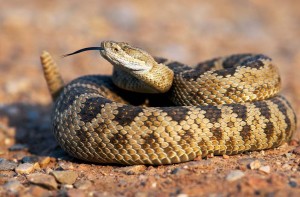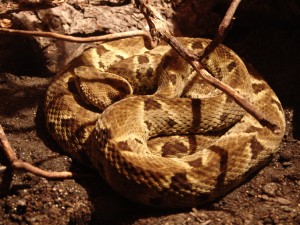Rattlesnakes (Crotalus spp.) are plentiful throughout the Americas, occupying various habitats from Southwestern Canada to Central Argentina, although most species live in the American Southwest and Mexico. They feed on small rodents, birds, and eggs, catching live prey by lying still and striking quickly with a venomous bite. Should the snake’s intended meal escape they are capable of tracking the prey by scent until the venom works and the creature dies. When threatened they shake the ‘rattle’ at the end of their tail, producing the distinctive sound that inspires their name.
The fer-de-lance (Bothrops atrox), a species of rattlesnake native to the tropical lowlands of northern South America, is a particularly aggressive snake. They typically grow 75-125 centimeters in length. It hunts primarily at night, using heat-sensing pits near its nostrils to zero in on prey. Although terrestrial, it is also comfortable in trees and water.
Because they are so ubiquitous, ancient artists from different indigenous cultures would be familiar with them, their appearance, and their behavior. Artists convey the rattlesnake by using brown tones and are inspired by the diamonds and zig-zags to add these markings to their depictions.


